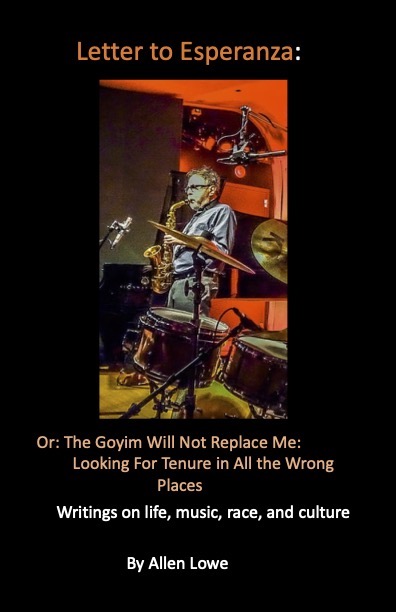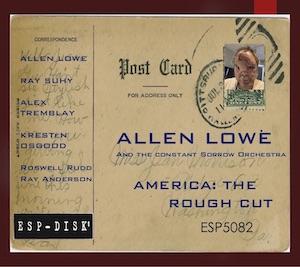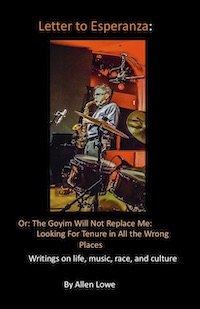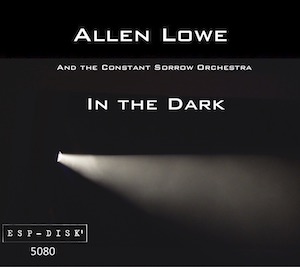-
Posts
15,392 -
Joined
-
Last visited
-
Days Won
4 -
Donations
0.00 USD
Content Type
Profiles
Forums
Events
Blogs
Everything posted by AllenLowe
-
which I will print here in its entirety, unless the moderators find it excessive. And if you like, it is not too late to order; I will briefly offer the whole project - two books and thirty cds - to all Organissimo members for $150 shipped USA, a discount from the usual $175 shipped USA: Allen Lowe. “ Turn Me Loose White Man” Or: Appropriating Culture: How to Listen to American Music, 1900-1960, vols. 1 & 2. Hamden, CT: Constant Sorrow Press, 2020/ 2021. x þ 352 pages, 397 pages, 30 CDs. by Eric Lott If you too have been waiting for a magisterial study of popular music animated by traditional racism and religiosity, victims of irony, dynamics of resistance, Christian warfare, God’s militia, the Confederacy in absentia, crimes of sentiment, country folk’s synchronized swim, praying for good sex, proletarian orchestras (in church), worldly cluelessness, the rhythm method (“a more subtle kind of resistance”), plant-based courtship (I’ll poke it through the window), love and booty, white moments of feeling, Death Be Not Barefoot, out of the mouths of white people, victims of style, and the Hawaiian version of the Baja marimba band, the wait is over. Allen Lowe’s “ Turn Me Loose White Man” Or: Appropriating Culture: How to Listen to American Music, 1900-1960 is here. The foregoing names only the first half of its table of contents more or less (vol. 1), but volume 2 follows suit (e.g., the minstrel wound, hillbillies with 401k’s, gospel in drag), and the writing lives up to its billing in punch and pith. All of it with a lucid and irrecusable rendering of the politics of cultural appropriation, but don’t expect a scolding, despite its how-to subtitle. Right on time with the arrival of The Harry Smith B-Sides (Dust-to-Digital’s new collection of the flip-sides of Smith’s famous 1952 Anthology of American Folk Music’s 78s), Lowe’s two prodigal volumes and their accompanying 30 CDs (each with 25-30 songs, 798 in all) far outpace the Smith compilations, which featured 84 A-sides and now 81 B-sides (three cut for racist lyrics) for a total of 165—not that it’s a contest, particularly since the projects do not conceptually overlap. Where Smith sought to conjure an occult Other America, Lowe means to trace various points of genre and stylistic inception, elaboration, and transformation, with an eye especially to the ways commercial song walked the color line. Greil Marcus in Invisible Republic: Bob Dylan’s Basement Tapes (renamed The Old, Weird America) (1997) famously argued that Smith in his Anthology created a “Smithville” in which racial boundaries sometimes became so blurred as to disappear. While often blurry in Lowe’s volumes, racial lines quite rightly haunt everything, lyrically, musically, and above all politically. The two volumes are appropriately titled. Lowe captures as well as anyone I’ve read the Jim Crow strictures and cruelties often audible in musical cultures that nonetheless are always all up in one another’s Journal of Popular Music Studies, Volume 35, Number 1, pp. 139–144, Electronic ISSN: 1533-1598 © 2023 by the International Association for the Study of Popular Music, U.S. Branch (IASPM-US). All rights reserved. Please direct all requests for permission to photocopy or reproduce article content through the University of California Press’s Reprints and Permissions web page, https://www.ucpress.edu/journals/reprints-permissions. DOI: https://doi.org/ 10.1525/jpms.2023.35.1.139 business, mostly to surprising effect. As I say, Lowe doesn’t finger-wag or preach over all this but rather explores, notes ironies, lays out contradictions, and not infrequently waxes mordantly funny at the results. And he is way beyond understanding Black music as the sum of its miseries. For Lowe, apartheid America structures but doesn’t a priori define the nation’s musical outcomes. Before digging in, it’s worth noting just what is in front of you when you encounter this stunning archival effort. Lowe’s ear-boggling retrievals of U.S. vernacular musicking going back to the late nineteenth century are all selected from his personal collection as exemplary pieces for his purposes. Since much of it on the early end is of poor sound quality, he did capable sound restoration on it. Mastering and digitizing multiple CD sets for distribution was no doubt an operation in its own right. Lowe did due diligence as discographer, tracking down personnel, recording dates, locations, and cultural coordinates for as many of the recordings as possible. And it was a one-man job: literary historians such as big-data “distant reading” Franco Moretti employ whole teams of researchers to do analogous projects. The books themselves, handsomely self-published, proceed essentially song by song through all 30 CDs from just before 1900 to around 1960, annotations that continually rise to the level of musicological and cultural analysis of a high and readable order; local insights connect to multiple arcs of development and sudden left-turn innovation in what feels like real time (as well as they are written, the books require readerly patience). It’s not unlike spending roughly 2,025 minutes or 34 hours—five whole business days with lunch breaks, more or less—listening along with an excited, loquacious, acute, and inexhaustibly knowledgeable host tracking and tracing certain evolutions in pop music over the first six decades of the twentieth century. No wonder Lowe writes in a preface that “this is really the last such project I will do, at least without a grant or a substantial cash advance (meaning that, yes, this is really the last such project I will do)” (I, 2). I’ll believe that when I (don’t) see it. Because that “last,” for those unfamiliar with Lowe’s work, alludes to a number of fine previous books (with accompanying CDs) including Really the Blues?: A Horizontal Chronicle of the Vertical Blues 1893-1959, That Devilin’ Tune: A Jazz History 1900-1950, American Pop—From Minstrel to Mojo: On Record 1893-1956, and God Didn’t Like It: Electric Hillbillies, Singing Preachers, and the Beginning of Rock and Roll 1950-1970, which over the years have garnered praise from Francis Davis, John Szwed, David Hajdu, Jonathan Lethem, Jody Rosen, Peter Stampfel, Robin Kelley, Greg Tate, and Greil Marcus, among others, the last two of whom provided tandem introductions to the books under review. And for those who don’t know, Lowe is an excellent and esteemed avant-garde saxophonist who has played and recorded with Julius Hemphill, Marc Ribot, David Murray, Roswell Rudd, Matthew Shipp, Gary Bartz, Don Byron, and many more, with more than twenty albums as leader to his credit. This high-end performance background, coupled with his scholarship, is certainly one context for the ear-driven distinctions Lowe makes throughout “ Turn Me Loose White Man”—his ear is trained, and he listens carefully. Indeed, thinking with his ears from pop to blues to country to jazz (and also, along the way, pre-jazz, precountry, minstrel, ragtime, folk, rhythm & blues, gospel, show music, and rock ‘n’ roll), Lowe, to note one instance among dozens, can suggest almost in passing that while Fred Van Eps’s “Florida Rag” (1912) is technically able, it is no match in spry facility for Vess Ossman’s “Chicken Chowder” (1906), and if you too can casually do that, more power to you (I, 41). And where Harry Smith and later commentators such as Marcus pursue a vaguely mystified, sometimes class- and race-blind vision of an esoteric America (and in this regard see also Rani Singh’s appallingly white- and male-centric documentary The Old, Weird America: Harry Smith’s Anthology of American Folk Music [2007]), Lowe in example after example hears otherwise: “the history of American music, to my ears, is essentially a timeline of African Americans liberating themselves in sound, creating an alternative history to that which has been imposed on them” (I, 9). Lowe’s governing emphasis on cultural appropriation has political currency, of course, but it’s to his great credit that he renders the matter with a confounding intricacy worthy of his materials. All down the line Lowe is level-headed and lucid—if at times blunt and candid—about the gnarled contradictions and paradoxes he finds. Operating with the now relatively uncontroversial notion that “a great deal, if not all, of American music is rooted in forms that derive in some way from Minstrelsy” (I, 15), Lowe consistently delivers the nuances of a given situation. In a history far messier than the mechanical theft of Black sounds and images for white sport and profit, U.S. musicking was through the decades an arena of exchange, larceny, fantasy, and desire structured in racial dominance in which each party (each of them multiple!) exerted its influence and lived through the changes, across many genres in many locations, fueled by widespread commercial distribution, whatever the format (street, stage, wax cylinder, shellac 78, radio, jukebox, vinyl 33 1/3). The upshot of all this, Lowe correctly notes, is that the broad diffusion of minstrelsy and post-minstrel cultural forms, Black as well as white, “created a mass movement of sound and motion that had shattering effect [sic] on all of not just American music but, categorically, American culture” (I, 15–16). Minstrelsy as the collective engine of cultural revolution—say what? That is, for better and worse, one of the main outlines of the story Lowe has to tell and attempts to track. Lowe’s song-by-song presentation of his musical examples tends to bury ledes (everywhere), but they nonetheless grab you. Here is one: Some of the strangeness of early jazz surely, I would say, has to do with the slow and gradual removal of the minstrel mask from both white and black performers. What lies beneath is still often an expression of perplexed, racial ambivalence, a sense that fantasy has replaced reality for so long that we no longer can determine precisely which is which. So black performers, as a habit (and not necessarily as a bad habit but as a professional habit), in the process of throwing off real and perceived professional chains, often remain in debt to a complicated and conflicted history of both professional and social enslavement, juxtaposed with a paradoxical form of liberation that is still part enslavement. (I, 51) “What lies beneath” the mask is less roots than once and future ambivalence and crossracial debt, liberation in chains, points of resistance and moments of supersession. As Stuart Hall once put it, this is the dialectic of cultural struggle.1 1. Stuart Hall, “Notes on Deconstructing ‘the Popular,’” in People’s History and Socialist Theory, ed. Raphael Samuel (New York: Routledge, 2016) [1981], 227–39. Lott | Book Review: “Turn Me Loose White Man” Where once it was commonplace to assume a clear distinction between debased culture industries such as minstrelsy and authentic folk and roots cultures both white and Black, it is now widely regarded a mixed-up, commercially saturated situation all the way down. As the blues arose in part out of traveling Black minstrel shows, so early country music often sported blackface on the National Life and Accident Insurance Company’s Grand Ole Opry stage. In this sense, Lowe contends, minstrelsy wasn’t dead but rather embedded everywhere, from the early-country minstrel religiosity of Ernest Thompson’s “Climb Up Them Golden Stairs” (1924) to Louis Armstrong’s hip yet flamboyant wresting of, signifying on, and thereby controlling the minstrel template to his advantage (I, 70). This at a time when Black sounds were unremittingly (and not unwittingly) infiltrating white musical modalities, with minstrelsy the vehicle, producing what Lowe calls the “deep and ugly contradiction” of a dominant culture attending to and inspired by a culture it continued to exploit (I, 72). Was white country music a communal gathering of the like-minded whose basic response to Jim Crow was to continue to do what came naturally, pursuing a method of liberation that didn’t appear to threaten anything? Or did it willfully submit itself to Black ideas and performance innovations in ways that radiated shocks through the system, however subtle? Yes to both, or Love and Thrift, as Lowe styles it in response to my notion of Love and Theft (II, 51).2 Lowe is fascinating on the fretboard intersections of country and blues in the banjo playing of (Black) Jimmy Strothers (1936) and the guitar of (white) Utah Smith (1944), who by turns (of phrase, even) fuse Black and white musical gestures while looking forward to both rock ‘n’ roll and bluegrass (II, 54–55). He does not shrink from proposing Al Jolson as a central figure influencing the development of American singing—check his analysis of the Jolson-y Black group The Bubbling Over Five (1929) (I, 227–28)—but is not unaware that Jolson occupied an altogether different sphere of influence than Charley Patton or Son House. Attuned to the complexities of minstrelsy, as well as segregated sound (in Karl Hagstrom Miller’s sally), privileging neither racial crosstalk nor apparently endogamous local knowledge, Lowe follows the music.3 He is as fresh on Armstrong’s singular innovations as he is precise on the ways Bing Crosby made cunning use of them (I, 137–8, 250). So it goes, in performers fleeting or enduring, local genre permutations and lasting subgenres such as honkytonk. Part of the irreducible pleasure of these volumes, impossible to convey in a review, is in seeing the year-to-year developments occasionally rise to the level of the transmundane (Elder Johnson’s amazing “God Didn’t Like It” [1948]) or explode by way of supernovas (Thelonious Monk at around the same time). Lowe proceeds with performer-by-performer discipline but is chatty and capacious enough in his purview to maintain a roomy feel (albeit with zingers aplenty). This produces a rather novel and indeed salutary music-history temporality in which stars and standouts live in the loam of everyday musicking that buttressed and sustained them. Lowe doesn’t mystify the nearly 2. Eric Lott, Love & Theft: Blackface Minstrelsy and the American Working Class (New York: Oxford University Press, 1993). 3. Karl Hagstrom Miller, Segregating Sound: Inventing Folk and Pop Music in the Age of Jim Crow (Durham, N.C.: Duke University Press, 2010). anonymous nor let genius take up too much space. It does annoy him that certain writers have tried to take Robert Johnson down a notch by restoring him to the milieu he came from, but then he doesn’t think much of Chuck Berry, a mostly amusing idiosyncrasy (I, 185). The point for Lowe, even when he’s just showing rather than arguing the case, is understanding better the contours of exchange and admixture by looking incrementally at the musical road everybody shared. Also hearing better how self-conscious the exchanges and historical attention often were. Lowe is great on Bob Wills and “country’s search for itself” in the 30s and 40s, built out of old-time fiddle playing, early jazz, Tin Pan Alley, and the Swing Era, hoedown show blues shot through with white jive (ahh-ha!); and he’s good again on Little Walter’s adaptation of old-style country blues to swing-era rules, planting his electrified harp between jazz time and blues accent, all of it audible in “I Just Keep Lovin’ Her” (1947) (II, 181, 189, 105). Lowe excels in isolating the almost scholarly riff allusions of Jelly Roll Morton, his way with Tiger Rag in 1938: “Like an old-days Jaki Byard he has a way of evoking a distant musical past through the surface of a porous musical present. Every note and turn of phrase is like a sideways-glance at some different and distant musical day, shaded by a very personal, present-tense, intellectually and aesthetically active cultural worldview” (II, 116). Ernest Tubb’s “Walking the Floor Over You” (1942), says Lowe, showcases country music’s equally self-conscious interest in conveying “graven images that come at us in three-minute sequences,” less “simple snapshots” than “sonic life studies” (II, 156). Lowe’s way with the issue of appropriation, in other words, opens onto musicking in and as everyday life, which the paratactic side-by-side procedure of these volumes strangely echoes, one after another life-giving medium channeling a broad array of elements: Hank Williams, Memphis Minnie, Faron Young, and Elizabeth Cotten; Little Richard, Little Jimmy Scott, and Lefty Frizzell; The Orioles and The Blue Ridge Quartet; Billy Love and Doris Day; Wanda Jackson, Link Wray, and John Coltrane. One of several compelling statements regarding this connection comes in Lowe’s remarks on what he terms an aesthetic of the homemade, or the homemade as an aesthetic, visible in artists such as Cow Cow Davenport but rising to new heights in Thelonious Monk. Monk, Lowe writes, comes not just from the blues but from that strange twilit zone where minstrelsy, the blues, dance, and old-time pop merged; not just from stride and barrelhouse but the whole house party tradition, where volume and rhythm were as important, if not more so, as melody and tone. Hence “a particular African American stylistic continuum” in which the music is not just self-taught (Black musicians often denied institutional training and traditional forms of employment) but home-made. “Sound in this musical environment was a matter of adapting to so many different kinds of repertoire—think Jug Bands, early plantation bands like Muddy Waters,’ the way in which even players like Charley Patton and Tommy Johnson played pop tunes—that everything was a music in the moment, and it led even musicians who had more of a ‘classical’ approach into some odd stylistic corners.” Imagine Monk touring with an evangelist, which he did: every jazz musician has played for occasions and affairs that demand they dredge up odd pieces of hokum. Monk and Sonny Rollins both, Lowe observes, tended to play out-of-the-way pop tunes, while before them James P. Johnson absorbed the sound Lott | Book Review: “Turn Me Loose White Man” and feel of the country dance and ring shout (which leads us back to Monk) (I, 327). Surely there are white, working-class and/or anti-“classical” versions of this “music in the moment” bricolage as well, and the notion offers up a welcome sense of how a lone performer might embody inventories of musicking that carry Lowe’s volumes across sixty or more years. All the way out to 1962, say, which finds a young Robert Zimmerman singing Richard Rabbit Brown’s 1927 “James Alley Blues,” more medicine/minstrel show than blues, Lowe notes, “stagey and warm,” a departure from what would become Delta style. Probably learning it from Harry Smith’s Anthology, Bob Dylan refuses white-boy mimicry, evoking the old school without self-parody. “Brows[ing] his way through the American vernacular,” like Lowe himself, Dylan at the end of these two volumes stands in for a way of working by absorption that it is Lowe’s determination to capture in most of his subjects throughout “ Turn Me Loose White Man” (II, 388). So even (or especially) if you’re not one of Those People—the R. Crumb obsessive 78 collector in rumpled corduroys and Coke-bottle specs indelibly captured in Terry Zwigoff’s Ghost World and Amanda Petrusich’s Do Not Sell at Any Price —or even if you are—Lowe makes an excellent Virgil. With great wit and energy, armed with a satchel of opinions, Lowe is never not alive to either the vagaries of cultural exchange or the social determinants that shape them. He helps you hear America better.
-
these are very nice, cosmetically very good; sound is really excellent. They don't have a lot of hours on them, as I have upgraded to a higher end of the same brand, Omega (the guy lives in Connecticut and makes excellent speakers) - at this price there is very little out there that is comparable - $400 plus shipping in the USA. My paypal is allenlowe5@gmail.com
-
"staggeringly glorious work" - Leo Murphy, KKUP (Cupertino, Ca) Order yours before this goes to my head and I do a Kafka thing and throw all the CDs in the fire.
-
I have grave doubts that Dolphy, who I do believe was playing with those guys, really said that. It sounds too much like the kind of things that anti-modernists fantasize that avant gardists really say in private. Dolphy was too dedicated to what he was doing, IMHO, to act as though it was all a pose. I wonder if it was in his Chico Hamilton days. But I don't know if Hamilton worked for Granz.
-
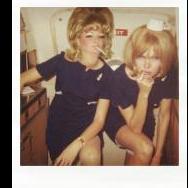
Newport (RI) Jazz Festival 2023 Lineup Announced
AllenLowe replied to tranemonk's topic in Live Shows & Festivals
yeah, I figured that out and even watched a few minutes. I'll take the original Dead, stoned out of their minds and drinking Owsley's Kool-aid, over these guys any day. -

Newport (RI) Jazz Festival 2023 Lineup Announced
AllenLowe replied to tranemonk's topic in Live Shows & Festivals
reminds me of a Nipsey Russell routine about working a tough joint in Harlem where they would take an intermission "to pull out the dead and wounded." -

Newport (RI) Jazz Festival 2023 Lineup Announced
AllenLowe replied to tranemonk's topic in Live Shows & Festivals
"Joe Russo's Almost Dead"- this guy stole my moniker. Actually, it's bad writing - are they saying that Joe Russo is "almost dead;" or. are they saying that the name of Russo's band is "Almost Dead"? Seriously, this is how semi-literate people get themselves in trouble. -
well, it's an early idea of swing - interviews with early New Orleans players tend to describe the early idea of jazz as speeding things up - this is the best sounding Europe CD, I think: https://www.amazon.com/Product-Our-Souls-Europes-Orchestra/dp/B07DW38S4F/ref=sr_1_1?crid=2J9MB2PAZFTP5&keywords=james+reese+europe&qid=1679018445&s=music&sprefix=james+reese+europe%2Cpopular%2C93&sr=1-1
-
great minds - I have been listening to this same CD this week for a New Orleans project I am working on. the difficulty in figuring all of this out is that there are so few true early black bands that recorded - and when they did record early on they usually could not use actual drums because of the limits of early technology - on the other hand (and this is probably an unpopular suggestion) listen the the Original Dixieland Jazz Band, which did have drums, and imagine, probably correctly, that they were doing what black bands were doing - or listen to James Reese Europe, whose drummer Buddy Gilmore was swinging like mad on some of those 1913 recordings. As for stride, yes, important, but notice how radically different James P.'s time is, compared to his playing before and after Armstrong. As for Patton and his ilk, these guys were regularly playing for dancers, and time was everything. And I agree they really swung, if in a somewhat different way than jazz musicians. Check this out: and:
-

the new stuff is here and almost here - order now -
AllenLowe replied to AllenLowe's topic in Offering and Looking For...
sorry I missed this; yes, ESP has it set up at: Allenloweesp.bandcamp.com -

the new stuff is here and almost here - order now -
AllenLowe replied to AllenLowe's topic in Offering and Looking For...
thanks -
American the Rough Cut ESPDISK single CD, $16 shipped media USA allenlowe5@gmail.com the book, Letter to Esperanza. $25 shipped media, USA allenlowe5@gmail.com In the Dark, 3 CDs $27.50 shipped media USA allenlowe5@gmail.com individual prices as marked - all 3 for $60 shipped media USA this will all be ready by April 1 allenlowe5@gmail.com email me with any questions
-
I have three major projects coming out as I have mentioned here ad nauseum: In the Dark, a 3 CD set with every musician I know: Ken Peplowsi, Lewis Porter, Aaron Johnson, Kelin Hannas, Brian Simontacchi, Lisa Parrott, me, etc etc. I can say forthrightly that this set is, compositionally and playing wise, as good as anything that's been out of late; these musicians, maybe not poll-winners, are masterful at combining the arts of chord-based improvisation with open playing, and our fusion of same is completely unique. These are all originals. Anthony Braxton has said of me that "Allen Lowe is an American master. He is the tradition, and one of the few musicians doing anything new." Larry Gushee commented "Allen Lowe has reinvented free jazz," and Kalaparusha said "Allen Lowe is a great composer." And John Szwed commented: “Allen Lowe is a genius! His work is always full of wonder, the excitement of discovery, and humor. I’m amazed by the energy and intelligence it takes to do this quantity of work at this level while on the margins of media and music. Yes, I know that the best work has always been done at the margins, by the so-called underground - Poe, Whitman, Monk, Harvey Pekar, Herbie Nichols, James Joyce, Sun Ra - but it’s still a surprise and a revelation whenever you find it.” If I had the money I would hire a publicist to do all this; but this is all me, self-produced and co-financed with ESP Disk, which is issuing all of these. So, next: America: The Rough Cut: A single CD of mostly American song forms. Remember everybody got mad at me when I said Allison Miller's group, good as it was, was clueless about being bluesy and funky? Well, here's a real answer to a lot of the jazz world, which is usually over-qualified when it come to playing roots music. This recording includes the incredible Kresten Osgood on drums, and the man I nominate as the best guitarist on the planet, Ray Suhy. Letter to Esperanza, or: The Goyim Will Not Replace Me: Looking for Tenure in All the Wrong Places This is my new book, which will be available in about 2-3 weeks. It is a collection of commentary on jazz, cultural appropriation, being a Jew (and dealing with, among other things, anti-Semitism), minstrelsy, the arts in general, academia, white and black country music (in collision with Rhiannon Giddens), rock and roll, and any other thing that has troubled me these last ten years. To avoid confusion, I will post pics of the projects on a separate thread here (if that's all right with the moderators) with pricing and specials. Thanks all, I know we have had some conflicts in the past, but any support you can offer will be appreciated. Though about two years ago I did not expect to still be here by now, I live on.
-

a few more CDs for your listening torture....
AllenLowe replied to AllenLowe's topic in Offering and Looking For...
here's what's left: Dave Brubeck Brubeck plays Brubeck Columbia Legacy STILL SEALED (I just couldn't get myself to listen) $9 shipped USA Wilton Gaynair Africa Calling Candid $9 shipped USA my paypal address and email is allenlowe5@gmail.com -
there was a nice lady, an old hipster ('50s type) whose brother was a well known writer, and we were talking about the 1950s jazz musicians she knew. When I mention his name she blanched and said she would never even say his name, for reasons she explained to me.
-
they gotta be kidding.
-
Actually only one is really torturous.... Dave Brubeck Brubeck plays Brubeck Columbia Legacy STILL SEALED (I just couldn't get myself to listen) $9 shipped USA the rest won't do you any harm: Wilton Gaynair Africa Calling Candid $9 shipped USA Dodo Marmarosa Pittsburgh 1958 Uptown $11 shipped USA my paypal address and email is allenlowe5@gmail.com
-
It's not what he said but what he did. Let's just say, remember that Beatle song "Boys"? Or maybe "Younger than Spring Time;" "Go Away Little Boy;" "I Want a Little Boy."
-

CDs for Sale get 'em while they're cold
AllenLowe replied to AllenLowe's topic in Offering and Looking For...
well, my wife looks around at all my crap, and after what happened to me in the last few years, I figure I better get it together. -
I have to admit that, much as I admire Joseph's playing, I know too much about him. Last time I said this about a musician everyone got mad at me for revealing some things, so I will keep it to myself.
-
this an old thread, and I apologize if I've already said this, but back in the '70s when I lived in NYC, two musicians - separately and completely independently of each other - said almost the same thing in almost the same words about Fruscella - Sir John Godfrey the drummer and Bill Triglia the pianist (one black and one white and there was no racial politics involved): "Fruscella was playing that style before Miles, and he had it together before Miles." Also, Triglia told me that Sonny Rollins used to go to Fruscella's place to rehearse with him. Imagine that.
_forumlogo.png.a607ef20a6e0c299ab2aa6443aa1f32e.png)

